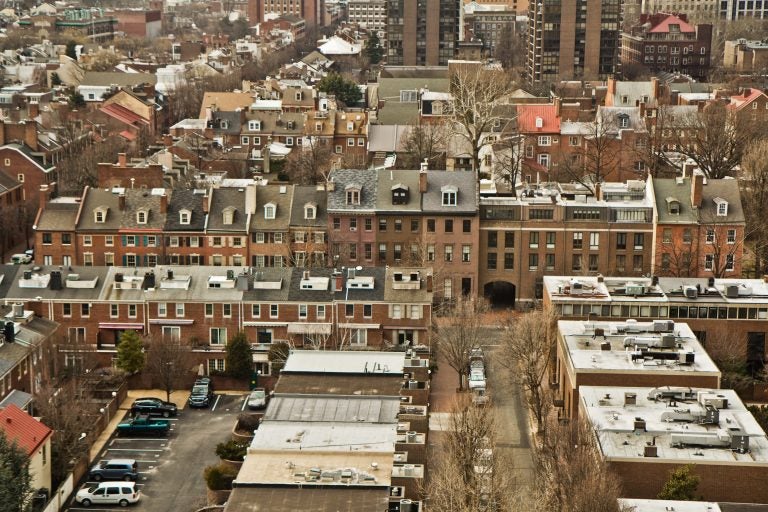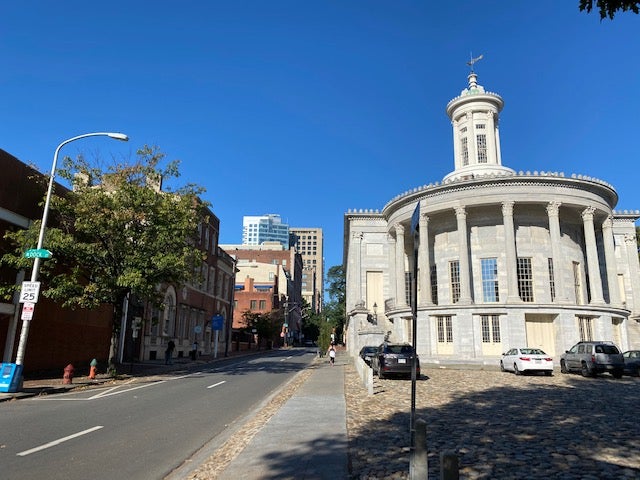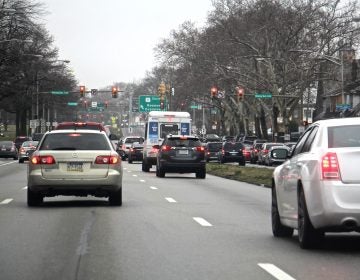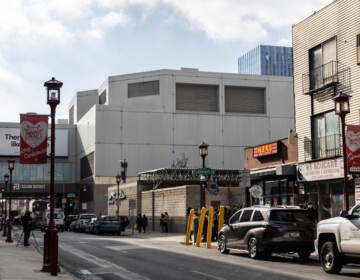The critics are wrong about Society Hill’s zoning bills
Two rezoning bills aimed at preserving Society Hill will not have exclusionary impacts, writes Society Hill Civic Association President Larry Spector.

A view of Society Hill taken from inside the Society Hill Towers. (Kimberly Paynter/WHYY)
City Council has unanimously passed zoning bills proposed by the Society Hill Civic Association that it believes are necessary for historic preservation. Critics say that historic preservation is a phony rationale from NIMBY-residents intent on excluding density and affordable housing from Society Hill. An op-ed published by PlanPhilly goes further by tossing off a reckless claim that we are “gaming the system” to keep housing accessible to only a white minority.
Can we just look at the facts?
There are the two bills:
First, as requested of all Registered Community Organizations city wide, the Civic Association produced a remapping of some parcels that made them more consistent with current usages and the recommendation of the Philadelphia Planning Commission to reduce “piano key” zoning of properties within the same block. This remapping was the result of extensive discussion and compromise. It was passed with the full support of the city’s Planning Commision.
Second, there is an “overlay” containing two height limits. They do not affect a broad swath of Society Hill as some claim, but only two small areas. A 65-foot height limit applies to only the south side of the 200 and 300 blocks of Walnut Street. That south side directly faces historic Park Service buildings, including the three-story Merchants Exchange Building, a magnificent National Historic Landmark situated across the street in a beautiful cobblestone plaza in Independence Historic National Park.
Developers have proposed projects for that block with heights and mass that would dwarf the Merchants Exchange. They would be completely out of scale with the streetscape that serves as a pathway into Philadelphia’s most historic area for carriage rides, tour buses and touring pedestrians. This is exactly the reason why the Preservation Alliance, the Park Service and members of the Architectural Committee of the Philadelphia Historical Commission have objected to such plans.
And none of the proposals are for mixed-income housing — they are for exclusively luxury units that would do nothing to address the affordable housing shortage in our city.
There is also a 45-foot height limit that applies to a single corner at 2nd Street and Lombard, and would simply keep heights approximately the same as every other building on the block facing the historic two-story Headhouse Shambles.

Nearby, Old City has a 65-foot height limit on their entire neighborhood. Boston, Baltimore and Georgetown all have even lower height limits, for the streets adjacent to their historic districts.
Another provision exempts Society Hill from recent legislation that would give zoning flexibility to old buildings self-designated by their owners to the historic registry. This broad sweeping legislation might help spur designations in many parts of Philadelphia but it backfires in Society Hill, where all our old buildings are already designated historic. If there is a need for flexibility, the answer is to consider a zoning variance, not change the regulations for the entire neighborhood.
Some argue that there is no truly historic value to preserve in Society Hill because it is much the result of the 1960’s demolition of moderate-income housing and urban renewal. But the Merchants Exchange and the Headhouse Shambles were not built on bulldozed land. They were there for many decades before urban renewal. The notion that the neighborhood as a whole is not worthy of recognition for the colonial architecture of hundreds of its homes — whether historically designated as original or as restored — would be a surprise to the many thousands of tourists who spend millions in Philadelphia for a visit that includes a tour of Society Hill.
The idea that Society Hill does not have density that permits affordable housing is just plain wrong. Density abounds in eight high-rise residential buildings in Society Hill and many other multi-family buildings. Rents in these buildings vary. More density is on the way with proposed development at Penn’s Landing. Society Hill supported recent legislation allowing hundreds of property owners to convert space in their homes into accessory dwelling units of affordable housing and we would welcome more as provided by the market or mandated by the city.
Larry Spector is president of the Society Hill Civic Association. He has lived in Society Hill for the last 45 years.

Subscribe to PlanPhilly
WHYY is your source for fact-based, in-depth journalism and information. As a nonprofit organization, we rely on financial support from readers like you. Please give today.







